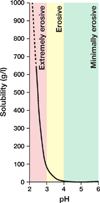The pH of beverages in the United States
- PMID: 26653863
- PMCID: PMC4808596
- DOI: 10.1016/j.adaj.2015.10.019
The pH of beverages in the United States
Abstract
Background: Dental erosion is the chemical dissolution of tooth structure in the absence of bacteria when the environment is acidic (pH < 4.0). Research indicates that low pH is the primary determinant of a beverage's erosive potential. In addition, citrate chelation of calcium ions may contribute to erosion at higher pH. The authors of this study determined the erosive potential measured by the pH of commercially available beverages in the United States.
Methods: The authors purchased 379 beverages from stores in Birmingham, Alabama, and categorized them (for example, juices, sodas, flavored waters, teas, and energy drinks) and assessed their pH. They used a pH meter to measure the pH of each beverage in triplicate immediately after it was opened at a temperature of 25°C. The authors recorded the pH data as mean (standard deviation).
Results: Most (93%, 354 of 379) beverages had a pH of less than 4.0, and 7% (25 of 379) had a pH of 4.0 or more. Relative beverage erosivity zones based on studies of apatite solubility in acid indicated that 39% (149 of 379) of the beverages tested in this study were considered extremely erosive (pH < 3.0), 54% (205 of 379) were considered erosive (pH 3.0 to 3.99), and 7% (25 of 379) were considered minimally erosive (pH ≥ 4.0).
Conclusions: This comprehensive pH assessment of commercially available beverages in the United States found that most are potentially erosive to the dentition.
Practical implications: This study's findings provide dental clinicians and auxiliaries with information regarding the erosive potential of commercially available beverages. Specific dietary recommendations for the prevention of dental erosion may now be developed based on the patient's history of beverage consumption.
Keywords: Erosive potential; commercial beverages; dental erosion; pH.
Copyright © 2016 American Dental Association. Published by Elsevier Inc. All rights reserved.
Conflict of interest statement
All authors report no conflicts of interest relevant to this article.
Figures
Similar articles
-
Analyses of the Erosive Potential of Various Soft Drinks and Packaged Fruit Juices on Teeth.J Contemp Dent Pract. 2018 Dec 1;19(12):1546-1551. J Contemp Dent Pract. 2018. PMID: 30713187
-
Estimated erosive potential depends on exposure time.J Dent. 2012 Dec;40(12):1103-8. doi: 10.1016/j.jdent.2012.09.004. Epub 2012 Sep 19. J Dent. 2012. PMID: 23000470
-
Sour sweets and acidic beverage consumption are risk indicators for dental erosion.Caries Res. 2015;49(3):243-50. doi: 10.1159/000371896. Epub 2015 Mar 4. Caries Res. 2015. PMID: 25765077
-
Addition of substances to reduce the erosive potential of acidic beverages to tooth enamel: A scoping review.Int J Dent Hyg. 2024 Aug;22(3):758-768. doi: 10.1111/idh.12791. Epub 2024 Mar 4. Int J Dent Hyg. 2024. PMID: 38439218
-
Sports drinks and dental erosion.Am J Dent. 2005 Apr;18(2):101-4. Am J Dent. 2005. PMID: 15973827 Review.
Cited by
-
Evaluating the pH of Various Commercially Available Beverages in Pakistan: Impact of Highly Acidic Beverages on the Surface Hardness and Weight Loss of Human Teeth.Biomimetics (Basel). 2022 Jul 26;7(3):102. doi: 10.3390/biomimetics7030102. Biomimetics (Basel). 2022. PMID: 35892372 Free PMC article.
-
Impact of customary fluoride rinsing solutions on the pellicle's protective properties and bioadhesion in situ.Sci Rep. 2017 Nov 29;7(1):16584. doi: 10.1038/s41598-017-16677-8. Sci Rep. 2017. PMID: 29185495 Free PMC article.
-
Evaluation of morphological traits, biochemical parameters and seeding availability pattern among Citrus limon 'Assam lemon' accessions across Assam.Sci Rep. 2024 Feb 16;14(1):3886. doi: 10.1038/s41598-024-54392-3. Sci Rep. 2024. PMID: 38365919 Free PMC article.
-
Quantifying the degree of white spot lesions on enamel caused by different commercial beverages using the Canary Caries Detection System: An in vitro study.J Dent Res Dent Clin Dent Prospects. 2022 Winter;16(1):29-34. doi: 10.34172/joddd.2022.005. Epub 2022 May 29. J Dent Res Dent Clin Dent Prospects. 2022. PMID: 35936932 Free PMC article.
-
A comparative evaluation of the effect of alcoholic and non alcoholic beverages on tooth enamel surface pretreated with β-tricalcium phosphate, bioactive glass and amine fluoride: an in vitro study.Med Pharm Rep. 2023 Oct;96(4):420-426. doi: 10.15386/mpr-2465. Epub 2023 Oct 26. Med Pharm Rep. 2023. PMID: 37970202 Free PMC article.
References
-
- Heller KE, Burt BA, Eklund SA. Sugared soda consumption and dental caries in the United States. J Dent Res. 2001;80(10):1949–1953. - PubMed
-
- Nielsen SJ, Popkin BM. Changes in beverage intake between 1977 and 2001. Am J Prev Med. 2004;27(3):205–210. - PubMed
-
- Storey ML, Forshee RA, Anderson PA. Beverage consumption in the US population. J Am Diet Assoc. 2006;106(12):1992–2000. - PubMed
-
- Jacobson MF. Liquid Candy: How Soft Drinks are Harming American’s Health. 2nd Ed. Washington, DC: Center for Science in the Public Interest; 2005.
-
- Gambon DL, Brand HS, Veerman EC. Dental erosion in the 21st century: what is happening to nutritional habits and lifestyle in our society? Br Dent J. 2012;213(2):55–57. - PubMed
Publication types
MeSH terms
Substances
Grants and funding
LinkOut - more resources
Full Text Sources
Other Literature Sources


